On Additives and Alterations: A Review of Ilona Németh’s Eastern Sugar
ILONA NÉMETH, EASTERN SUGAR, KUNSTHALLE BRATISLAVA, APRIL 13 – JULY 15, 2018
Seen in the shape of its mountains and the growth patterns of its aging population, the conical sugarloaf is often used to describe forms in Slovakia’s physical and social landscape.(Stephen Joseph Palickar, Slovakian Culture in the Light of History: Ancient, Medieval and Modern (MN: Hampshire Press, 1954), p. 53; Roy E. H. Mellor, Eastern Europe: A Geography of the Comecon Countries (London, UK: Macmillan Press Ltd., 1975), p. 115.) As a “body” with “weight…we can neither see nor touch,” the sugarloaf is also the object that Karl Marx used to illustrate how relative value works among commodities.(Karl Marx, Capital: A Critical Analysis of Capitalist Production (London, 1887. Berlin: Dietz Verlag, 1990), p. 48.) In Marx’s analogy, just as the coat represents value in relation to linen, the sugarloaf had to be put in “weight-relation” with pieces of iron to represent value.(Marx, Capital, p. 48.) In Eastern Sugar, Ilona Németh’s most recent exhibition at the Kunsthalle Bratislava, the sugarloaf finally stands in relation to itself.

Ilona Németh (in collaboration with hired workers and exhibition visitors), “Sugar Loaves (Eastern Sugar),” 2018, packed sugarloaves, 60 dkg and 35 dkg. Image courtesy of the artist.
Visitors invited to make sugarloaves at various “manufacturing” stations within the exhibition were made to feel its weight as they carried a loaf away as a souvenir. However, the sugarloaf in Eastern Sugar is a body whose value is not only symbolic, economic and geopolitical, but also relational and affective. As such, Eastern Sugar was a complex, multilayered performance of a new kind of discursive “specific object,” a postminimalist combination of industrial materials, installation, choreography, architecture, historical research, narrative, and political geography.(Minimalist Donald Judd defined the “specific object” as neither painting nor sculpture, but as a three-dimensional work that abandons the part-to-part logic of European modernism for the “singleness” of specificity: “three dimensions are real space. That gets rid of the problem of illusionism and of literal space, space in and around marks and color—which is riddance of one of the salient and most objectionable relics of European art.” Judd quoted in Briony Fer, On Abstract Art (New Haven, CT: Yale University Press, 1997), pp. 131-33. See also Donald Judd, “Specific Objects (1965),” Donald Judd: Writings (New York, NY: David Zwirner Books, 2016).)
The sugarloaf, once a popular commodity object for sugar consumption in Central Europe, was the result of a long procedure.(Lewis Sharpe Ware, Beet Sugar Manufacture and Refining, Vol. II, Evaporation, Graining and Factory Control (New York: John Wiley and Sons, 1907), pp. 423-39.) Remelting, filtration, and graining. Casting, purging and curing. Centrifuging, heating, lathe turning, and, finally, wrapping. In Németh’s Eastern Sugar, visitors used a more minimal gesture to memorialize this process, gently grinding and pounding sugar granules with pestle and mortar. Wearing white aprons pulled from a wall rack in the Kunsthalle’s first-floor main hall, visitors followed instructions posted at one of thirty-six stations to make their own sugarloaves. With pestles in grip, hands felt the abrasion of grain against the resin belly of the mortar as they pressed loaves into shape. This play with “sugar castles”—portable, unlike their sandy equivalents—was simultaneously ennobling and reductive for both laborer and loaf. The amount of work and equipment involved in the original process of refining and packing was, of course, lost in this melancholic resuscitation of the sugarloaf. In Eastern Sugar, the return of the sugarloaf stands for what is now seen as just another castle-in-the-air of post-communism in Central Europe: the fair and equitable privatization of nationally-protected, state-owned industries that would benefit the region’s citizens.
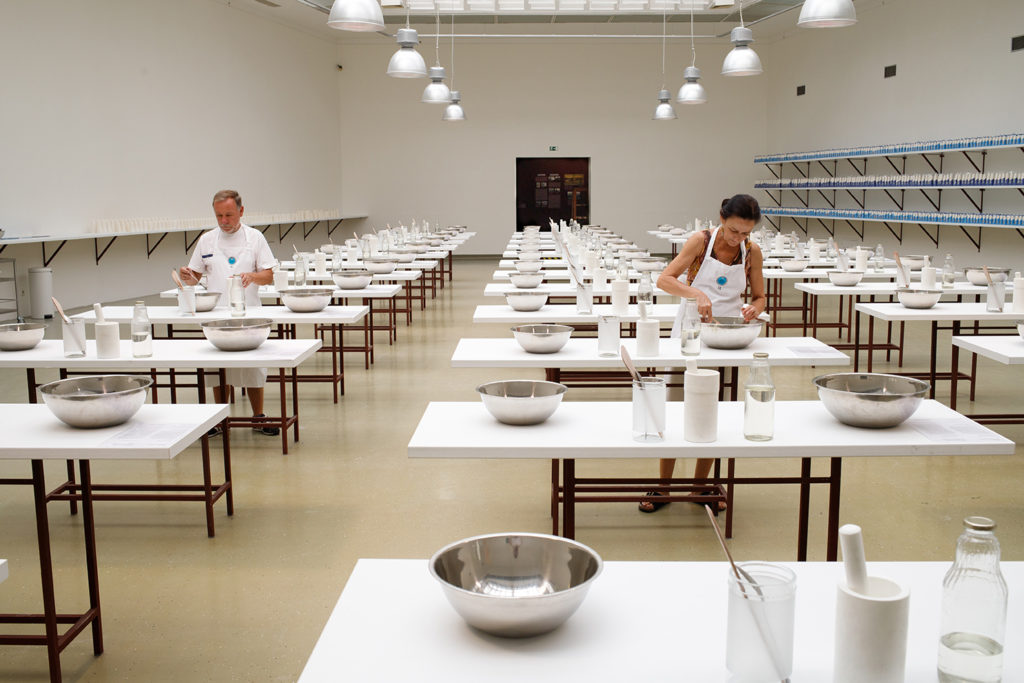
Ilona Németh (in collaboration with hired workers and exhibition visitors), “Sugar Loaves (Eastern Sugar),” 2018, packed sugarloaves, 60 dkg and 35 dkg. Image courtesy of the artist.
Scores of loaves made not only by visitors, but also by hired exhibition workers and the artist herself, lined shelves on one side of the Kunsthalle’s main monumental space. After being sheathed in plastic and sealed with an “Eastern Sugar” medallion designed by Németh, the white cones stood glittering at attention, awaiting presentation. Indeed, in the nineteenth century, the task of wrapping loaves required paper forms that were specially patented for the purpose.(Ware, Beet Sugar Manufacture and Refining, p. 439.) Visitors to Németh’s exhibition contributed to a production cycle and were presented with half the amount of packed sugarloaves they produced: a gift for participation that did not pretend to be compensation for work. Loaves could be acquired without labor for a symbolic cost (1 EUR for a small loaf; 2 EUR for a large loaf), but as the artist explained: “We prefer to involve [visitors] in production.”(E-mail exchange with Ilona Németh, July 10, 2018.) This simplified replication of the stages of factory refining, packing, and labor relations is an almost sardonic take on relational aesthetics and contemporary neo-Marxist approaches to making art about labor conditions in late capitalism.
This important mid-career exhibition of one of Slovakia’s most respected artists exemplified the agility of a politically engaged art practice that avoids didacticism with an acute sensitivity to the power of objects and the life of materials. The exhibition takes its title from the name of the Franco-British enterprise Eastern Sugar. The company was created by Générale Sucrière and Tate & Lyle, the latter founded by Henry Tate who ironically used its profits to develop London’s first Tate Gallery for art.(“History of Tate,” Tate. Accessed July 10, 2018: https://www.tate.org.uk/about-us/history-tate.) As is typical of Németh’s practice, the exhibition is told through a polyphony of voices, human and non-human, biotic and abiotic. Sugar is given its voice through the sugarloaf via an object-oriented approach that Németh has used before. For example, in The Harpoon Project (2013-2014), she covered the floor of the University of Massachusetts Dartmouth Art Gallery, in New Bedford, with clay toggle irons inspired by harpoons used in the city’s whaling industry. The project—a collaboration with university students, city residents, and gallery director Viera Levit—based its clay iterations on a specific harpoon design that was the invention of Lewis Temple, an African-American abolitionist, blacksmith, and former slave, who had resettled in New Bedford from Florida.(Viera Levitt, “Ilona Németh: The Harpoon Project. Site-Specific Installation for New Bedford,” University of Massachusetts Dartmouth Art Gallery (November 14, 2013 to January 26, 2014). Accessed July 10, 2018: https://www1.umassd.edu/cvpa/universityartgallery/past/2013/harpoon_project.cfm.) Throughout her works, Németh has consistently explored repetition, replication, and the use of readymade or refabricated reference objects, from the 110 railroad crossties salvaged and installed from a deactivated railway line believed to have carried Jewish residents of Slovak-Hungarian bordertowns to concentration camps (The Way, 1996), to conventional bleacher seating used to create a stageless arena where spectators have only each other to watch (Auditorium/Hľadisko, 2012).
Objects tell a chapter of the story relayed in Németh’s recent exhibition, while architecture and people tell another. The history of the Eastern Sugar company is recounted in interviews with former sugar industry operators, conducted by the artist and shown in a video installation. After the fall of communism, Eastern Sugar privatized several formerly state-owned sugar factories in four Central European countries—Poland, Hungary, Czech Republic and Slovakia. Due to shifts in the geopolitics of sugar, the company had to close several of the factories it had acquired after investing in equipment updates and running production for a number of years. It subsequently refocused its attentions away from producing and refining Central European sugar to trade in Western European sugar from Germany and Austria.(Ilona Németh, Interview with Christian Laur – former member of the Managing board of Eastern Sugar 1993-2000. Single channel video, color, sound, 16:20 min. Trnava, Slovakia: Cukru Production, 2018.) The dismantling of the Slovak sugar industry became a metonym for the neoliberalization of the region as the European Union (EU) submitted to the free-market fundamentalism being implemented by the World Trade Organization (WTO).
The narrative about the Slovak sugar industry that Németh presents in her exhibition is at once wistful and subtly ironic. Irony can be sensed in the deliberate way Németh replays Eastern Sugar’s takeover of the Slovak factories: she plays the part of the Franco-British conglomerate with her use of embossed and embroidered branding, her management of the exhibition space, and her issuance of temporary labor contracts to exhibition workers. Thus, she “privatizes” memory of an economic event by personalizing it. Although a sense of longing is not always explicit, it is nonetheless present. For example, the thirty-six tables that serve as stations for the fabrication of sugarloaves are designed after the greenhouse table the artist remembers her father, Jenő Németh, working at when she was a child. A leading representative of the Czechoslovak Socialist Republic, Jenő Németh lived with his family in Dunajská Streda, a bordertown between Slovakia and Hungary where his artist-daughter—an ethnic Hungarian of Slovak nationality—still lives. From Németh’s video interviews, visitors learn that Dunajská Streda was also home to the largest and most productive of Slovakia’s ten sugar factories, a facility that processed approximately 4,000 tons of sugar beet.(Németh, Interview with Christian Laur, 2018, and Németh, Interview with Dušan Janíček – director of External Relations Slovenské cukrovary, s.r.o., Sered’, AGRANA Group, 2017. Single channel video, color, sound, 14:28 min. Trnava, Slovakia: Cukru Production, 2017.) Despite its good numbers, the factory was shut down and demolished when, under pressure from the EU to reduce sugar production in response to WTO negotiations with India and Brazil, the Eastern Sugar conglomerate decided to accept compensation in exchange for not producing the factory’s sugar quota.(Németh, Interview with Christian Laur, 2018, and Németh, Interview with Dušan Janíček, 2017.) Once a company received quota compensation for a factory, the EU’s “sugar regime” required the factory be demolished so it could never produce sugar again.(Németh, Interview with Dušan Janíček, 2017.)
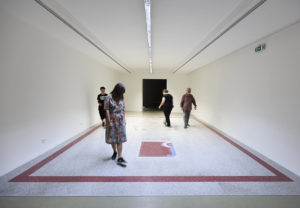
Ilona Németh, “Juhocukor,” 2018, site-specific installation using original linoleum flooring (ca. 1990s) from Juhocukor factory (later: Eastern Sugar), Dunajská Streda / Dunaszerdahely. Image courtesy of the artist.
Németh’s planning of the Kunsthalle exhibition took place over years of driving to Bratislava past the Dunajská Streda factory’s administrative office, the only building left standing after the demolition of the factory itself. Németh arranged to remove the office’s linoleum floor, fearing it would also come under bulldozers, and reinstalled it in the back gallery of the Kunsthalle. Emblazoned with the factory logo—Juhocukor (Southern Sugar)—it also holds the ghostly outline of the base of a reception desk and a punch-card station.
After falling into disuse in the twentieth century as Europe’s preferred form for packaged sugar, the sugarloaf became a symbolic object that the Slovak industry used to inaugurate its annual production cycle, the campan.(Conversation Ilona Németh during the artist’s exhibition walk through, Kunsthalle Bratislava, Slovakia, June 13, 2018.) The cycle lasts three to four months and involves the processing of the sugar beet and the production of sugar.(E-mail exchange with Ilona Németh, July 12, 2018.) Németh’s exhibition gives new value to the rounded cones once proudly displayed in the parlors of Czechoslovak, and later Slovak, households. At the same time, it uses this revalorization of an object of both material and culinary culture to mourn the loss of the manufacturing sector in a country where the service industry now employs most workers, and youth unemployment is relatively high.(“Economic Affairs (Slovakia),” in Europa World online (London, U.K.: Routledge, 2013-2018). Accessed July 10, 2018: http://www.europaworld.com.i.ezproxy.nypl.org/entry/sk.is.52.) The exhibition workers hired by Németh through an employment agency sustained steady production of sugarloaves at the Kunsthalle under the monumental glazed roof of its main hall. Their presence reminds visitors of the livelihoods lost with the decline of the industrial economy.
Németh’s exhibition left visitors with the feeling that any angst over the privatization of the Slovak sugar industry actually mourns the loss of hope and promise more than the actual industry itself. For example, the two interviews presented in the Eastern Sugar video installation show the artist engaging two responses to privatization: in one video, edited with footage of factory machines and operations, a director of the Sered’ factory (still functional under Austrian ownership) asserts privatization was the “biggest mistake;” in the other, interspersed with shots of factory architecture, a former board member of Eastern Sugar insists there was “no good solution” to downsizing sugar production in EU member states, but claims privatization was not to blame.(Németh, Interview with Christian Laur, 2018, and Németh, Interview with Dušan Janíček, 2017.)
The social history of the sugar industry presented by Németh is complemented by a kind of critical formalism. The serial repetition of sugarloaves in the main hall of the exhibition, brings attention to the sugarloaf’s quasi Cubist or Suprematist reduction of the sugar-beet’s fleshy taproot into a geometric shape: the loaf purifies the irregular bulbous body of the beet into a rigorous cone. This attention to the beet’s geometric “refinement” is representative of the artist’s attention to structure and construction in the exhibition. To revitalize visitors’ experience of Bratislava’s Kunsthalle—a space notorious among local artists for being difficult to negotiate—Németh executed a series of significant architectural alterations to its interior spaces in collaboration with Marián Ravasz and Plural Architects.(Conversation with Ilona Németh during the artist’s exhibition walk through, Kunsthalle Bratislava, Slovakia, June 13, 2018.) She redesigned the Kunsthalle’s first-floor layout, sealing the double entryway that usually welcomes guests into the luminous central hall. Instead of finding their way directly into the hall from an impressive marble foyer flanked by grand staircases, visitors could only access the hall after passing through two side galleries.
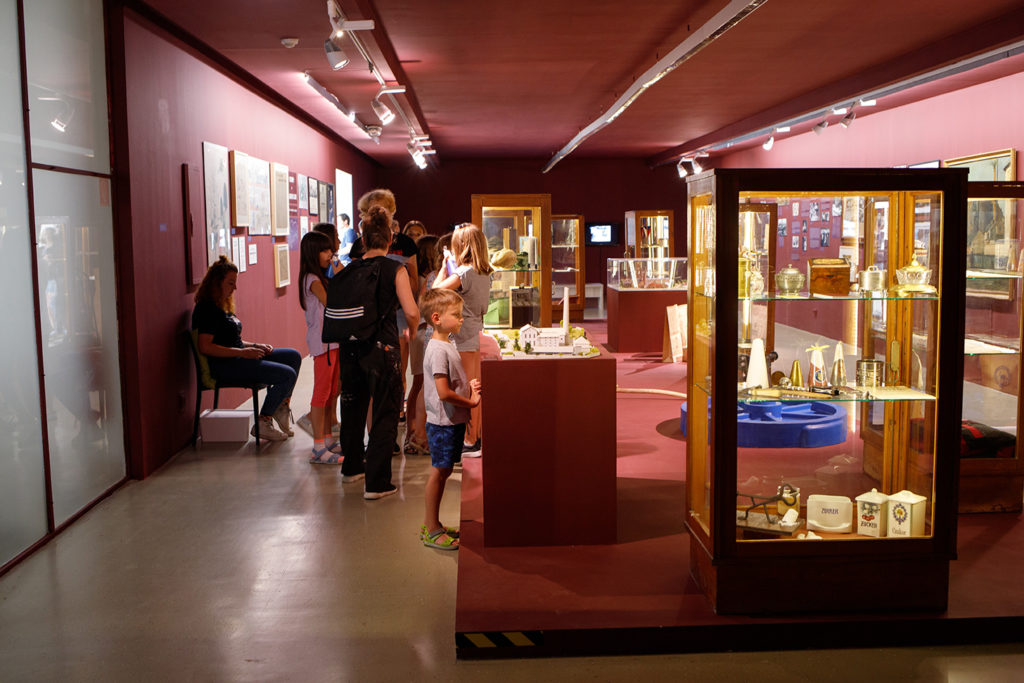
Miroslav Eliáš, “Museum of Sugar,” 2018, mixed media, dimensions variable. As part of the Eastern Sugar exhibition, Ilona Németh invited Miroslav Eliáš to set up a pilot version of his Museum of Sugar project. Image courtesy of the artist.
Lateral passageways thus replaced a pair of central doorways, introducing visitors to the main hall through two distinct trajectories, compelling them to make a choice. Visitors who entered the exhibition on the right came upon the main hall and its sugarloaves after passing through the prototype of a museum dedicated to the history of Slovak sugar. Entitled the Museum of Sugar, it was created by museologist Miroslav Eliáš at Nemeth’s invitation. The trajectory through Eliáš’s gallery confronted visitors with Socialist Realist landscape paintings commissioned to portray sugar factories, copies of portraits painted to exalt factory directors, and museological models built by Eliáš to help visitors better conceptualize the now decayed shells of former factory architecture.
Meanwhile, the passageway to the left led through Németh’s video installations and displays of photographs on hanging mobile screens (Archive, 2017-2018), both of which acted to place visitors inside the cathedral-like spaces of factories that Eliáš’s museum represented as objects to be analyzed. After marveling at Németh’s dramatic drone footage of the Pohronský Ruskov factory—a bare skeleton of a structure with broad timber beams like whale ribs and a majestic octagonal chimney—visitors found themselves led by the artist’s design into the first floor’s main hall under an impressive wrought-iron skylight over her thirty-six sugarloaf stations. Németh lowered the hall’s large aluminum lamps on chains, using the industrial appearance of the fixtures to trigger recall of the spectacular roof of the defunct factory at Pohronský Ruskov.
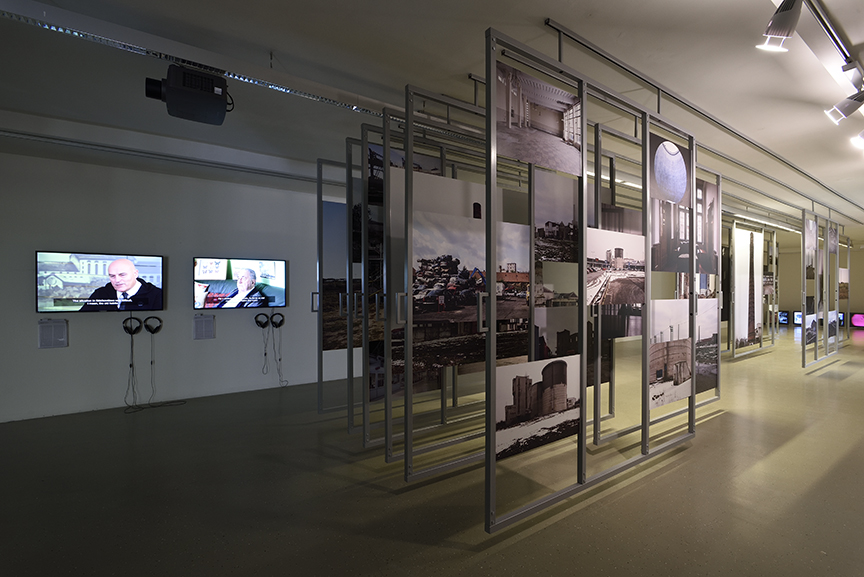
Ilona Németh (in collaboration with Olja Triaška Stefanović [photo essay], Cukru production, and Marián Ravasz [architect]), “Archive,” 2017-2018, videos, photographic archive, text and steel display structure, dimensions variable. Image courtesy of the artist.
This is not the first time Németh has made a statement with her subtle yet provocative alterations to an important art space. In 2011, she cordoned off the second floor of the Ernst Museum in Budapest for the exhibition Dilemma (2011-2012), signaling another loss: the absence of the artist’s originally planned exhibition that, for political reasons, had become impossible to stage without completely distorting its aesthetic and conceptual stance.(For more on this exhibition, see Dilemma: Three Central-European Versions of Ilona Németh’s Exhibition, Ed. Edit András (Bratislava, Slovakia: Kalligram, 2013).) The complex of exhibitions organized for the Višegrad cities of Trnava, Budapest, Brno, and Poznań was supposed to center around a video interview with Ágnes Heller (Zsófia Meller, 2012) in which the Hungarian-Jewish philosopher recounted her grandmother’s experience being forced to sit behind a screen to attend lectures as among the first women to attend the University of Vienna. However, a media spectacle involving Heller threatened to shift the focus of this plan. After being criticized for his tyrannical concentration of power, Hungarian Prime Minister Viktor Orbán announced he would launch an investigation into the sources of grants received by Heller and four other Hungarian philosophers. Németh’s cordon at the Ernst Museum amplified the silence of artistic expression foreclosed in the face of a political circus that made the issues of exclusion she had wanted to explore with the Heller interview impossible to engage. Thus the artist used the cordon to evoke the “screen” Heller described and withdrew the video interview that would have made Heller, and Orbán’s attacks, the focus of the exhibition. In place of the Heller interview, Németh turned the gaze of visitors upon her own quandary: the first-floor of the Ernst Museum featured new video interviews in which Németh herself laid bare her concerns about the impossible position the institution had asked her to take.
In Eastern Sugar, Németh’s alterations are more architectural, but play with the same dialectic between the additive and subtractive as the cordon. The changes the artist made to the first-floor hall of Slovak architect Miloš Chorvát’s 1957 Národné Osvetové Centrum (the National Cultural Center transformed in 2014 into the Kunsthalle Bratislava and later the Slovak National Gallery) similarly animate an obdurate situation, in this case a difficult space. Indeed, Chorvát’s building—constructed under Communist rule when industrial growth in Czechoslovakia was at its height—feels as if it had realized the full potential of both its historic and contemporary aims. Németh’s exhibition succeeds at being both educational and aesthetic, recalling the mission of the Communist National Cultural Center as it was originally conceived by its Czechoslovak founders.
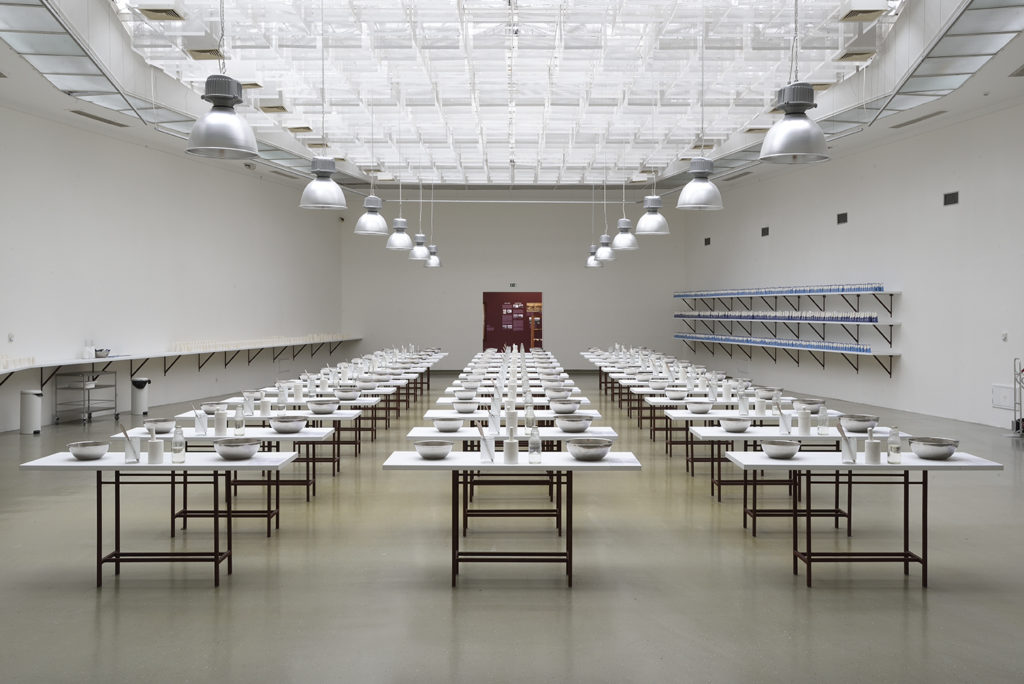
Ilona Németh, “Sugarloaf Manufacture,” 2017-2018. Manufacturing workshop with 36 working stations, sugarloaf forms and utensils, packaging material, various objects, lamps, and backspace for workers, dimensions variable. Image courtesy of the artist.
Németh’s architectural tactics and display strategies transform Eastern Sugar into what feminist architectural historian Jane Rendell calls “site-writing.”(Jane Rendell, “Critical Spatial Practices: Setting Out a Feminist Approach to Some Modes and What Matters in Architecture,” Feminist Practices: Interdisciplinary Approaches to Women in Architecture, Ed. Lori Brown (London, U.K.: Routledge, 2011), p. 35.) Site-writing, as Rendell describes it, is “what happens when discussions concerning site-specificity extend to involve criticism:” it is the “spatialization of criticism” in which “criticism operates as a form of practice.”(Rendell, “Critical Spatial Practices,” p. 35.) Németh’s use of Chorvát’s space to explore the Slovak sugar industry in its socioeconomic, architectural, and aesthetic guises reflected back on the site it occupies, posing indirect questions about the culture industry and the role of contemporary art in neoliberal Slovakia. As extract pulled from the sugar beet through slicing, boiling, diffusing, and pressing, the Slovak beet sugar demanded an equally complex processing of spatial framing for the presentation of its story.
The back hall that connected the lateral galleries found the artist confidently curating other responses to the postindustrial condition alongside the linoleum floor she transplanted from the factory office at Dunajská Streda. The five works shown—three sculptures, a video installation, and a 16mm film essay—are by four international artists from different generations: Harun Farocki, Jeremy Deller, and the collaborative duo Lonnie Van Brummelen and Siebren de Haan. Farocki’s twelve-channel video installation explores representations of factory life in the history of cinema, while Deller’s objects and Brummelen and de Haan’s silent 16mm film address exploitation and absurdity in both new labor practices and neocolonial trade relations. Meanwhile, in the pamphlet-map that visitors used to navigate Németh’s alterations to Bratislava’s Kunsthalle, curator Nina Vrbanová compared Németh’s architectural interventions to emerging German artist Anne Imhof’s praised architectural reworking of Germany’s Nazi-era Venice Biennale pavilion for her Black bloc iteration of Faust (2017), presented in anti-fascist militant guise. Imhof and Németh, Vrbanová argued, took a similar approach to site-responsiveness in their “redefinition of (…) architecture (…) as a mental-performative space.”(Nina Vrbanová, “Eastern Sugar: Reconstruction of Reality in Time,” Exhibition Pamphlet for Ilona Németh: Eastern Sugar, Kunsthalle Bratislava, April 13 – July 15, 2018.)
With its alterations to entrances, its ninety-three-centimeter-high glass floor, and surrounding glass walls guarded by living Dobermans, Imhof’s pavilion, despite its anarchist appeal, came across as a nihilist submission to totalitarian aesthetics that wryly subverted liberal values, seducing audiences with its images of reactionary passivity. Németh’s manipulation of space is, instead, unabashedly activist, seeking impact beyond the exhibition itself: she hopes the Eastern Sugar exhibition will result in both the preservation of the octagonal chimney tower at the factory site in Pohronský Ruskov, and in a permanent location for Eliáš’s Slovak Museum of Sugar.(Conversation with Ilona Németh during the artist’s exhibition walk through, Kunsthalle Bratislava, Slovakia, June 13, 2018.)
Like two sides of a Möbius strip, however, the opposing approaches of Imhof and Németh meet. The interactivity staged in Németh’s exhibition—the fabrication of sugarloaves—feels designed to be slightly infantilizing, intentionally disempowering. Németh is an artist who always aims to occupy a position of inbetweenness; indeed, the visitor to Eastern Sugar who makes a sugarloaf should feel the tug of nostalgia for a lost opportunity, but must also leave the gallery with a sense of alienation rather than satiation. Indeed, Eastern Sugar deftly cycles the sugarloaf in and out of reification. At moments, it feels as though the miniature sugar towers govern visitor activity, instrumentalizing viewer participation for their replication as though they were independent creatures of a thing-world. At the same time, the loaves pull visitors into the experience of a social universe of human relations from which Németh shows them to be inseparable.
In 2011, Sweden’s Moderna Museet hosted a three-day symposium by the KTH School of Architecture to pose the question, “How does architecture as a discipline think about alteration? Is our theory and method for confronting the existing sufficient?”(Alteration: Architecture as a Making Discipline and Material Practice, Ed. Tin Anstey and Catharina Gabrielsson. Symposium at Moderna Museet, KTH School of Architecture, August 31 – September 2, 2011. http://architectureinthemaking.se/events/alteration.) In Eastern Sugar, an exhibition that takes a taste-altering food commodity as its subject, alteration as a critical tactic in art and architectural practice is foregrounded. Sealing doorways, lowering lamps, mounting walls, opening passageways, and even transforming a mop closet into a fully functional “back space for workers” (closed to exhibition visitors but included in the exhibition map), the artist creates a spatial double for the sugar factories whose loss her exhibition critically laments. Németh manipulates kinesthetic sensation, manifesting the physical sense of a lost space rather than pointing to it. In doing so, she makes Eastern Sugar more than just a seminal show in her individual career.
While Németh was mounting Eastern Sugar, Slovak Prime Minister Robert Fico resigned in response to street protests in Bratislava that demanded justice for murdered journalist Ján Kuciak and his fiancée Martina Kušnírová. The resulting “reshuffle” that saw the former premier from Smer-SD (Direction-Social Democracy) replaced by a senior member of the party was met with further protest.(Siegfried Mortkowitz, “Slovak PM Robert Fico Resigns,” Politico, March 16, 2018. Accessed August 29, 2018. https://www.politico.eu/article/robert-fico-resigns-slovakia-prime-minister/.) In 2011, Németh collaborated with a film industry expert to create a “tornado-like object” (Fog, 2011) for Bratislava’s Námestie Slobody (Freedom Square). Using specially designed tools adapted from helicopter engines, the work generated analog “storm” effects in Slovakia’s representative public plaza.(E-mail exchange with Ilona Németh, September 9, 2018.) Németh has described the work as creating an “environment for reconstruction through a process of destruction,” a commentary on the square as a site where “politics turned itself into rituals and falsely declared a vision of better tomorrows.”(Ilona Németh, “Námestie Slobody Project,” Ilona Németh. Artist Website. Accessed August 29, 2018. http://www.ilonanemeth.sk/works/2011/.) In the present climate of exasperation, Németh’s Eastern Sugar was another proposition for a tactics of alteration, a subtle though sharp mode of critical institutional infiltration fit for a moment of democracy in despair.




